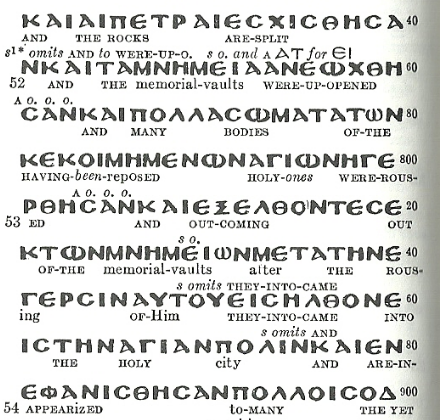an enigmatic resurrection (2)
09-05-2014 - Posted by Andre Piet The last blog about the difficult passage in Matthew 27:52 and 53 was in my experience somewhat unsatisfactory, because important questions remained unanswered. For example, why do we read nothing in the other evangel accounts about the resurrection of many saints. These events must have had a big impact? And why is it that we hear nothing of the further happenings to these resurrected saints? Anyway, if the passage in question says it, then we must take all the questions it raises, just for what they are, because one thing is beyond dispute: “the Scripture cannot be broken” (John 10:35). In the comments about the previous blog, however, someone pointed me to an alternative reading in a Peshitta translating, which is, in my opinion, worth considering. It comes down to this: the opening of the graves was caused by the rocks that tore apart. That is the logical connection that the text suggests: “… the rocks tore apart and the graves were opened”. In addition, it is noteworthy that there is no mention of the resurrection of saints, but of the bodies of saints who were ‘roused’, i.e. the bodies moved and were disturbed in their grave. Many tombs were opened by the earthquake and the bodies came out. Not as being alive, but dead. And after Christ’s resurrection (i.e. after the Sabbath) all this was seen by many who came into the holy city. But does it not say that these saints, themselves, went into the city? Indeed, according to most manuscripts of the NT, it says so. But … in one important manuscript, the Sinaïticus, the words, “they came in” are missing (see the grey shaded words in the interlinear below). In the Sinaïticus the focus is not on the roused bodies entering the city, but that the roused bodies were seen by those who entered the city. They saw the torn rocks, the opened graves and the bodies that had been moved out of their graves. A very different scenario. In a Dutch translation of the mentioned Peshitta, an ancient Aramaic manuscript, I came across this:
The last blog about the difficult passage in Matthew 27:52 and 53 was in my experience somewhat unsatisfactory, because important questions remained unanswered. For example, why do we read nothing in the other evangel accounts about the resurrection of many saints. These events must have had a big impact? And why is it that we hear nothing of the further happenings to these resurrected saints? Anyway, if the passage in question says it, then we must take all the questions it raises, just for what they are, because one thing is beyond dispute: “the Scripture cannot be broken” (John 10:35). In the comments about the previous blog, however, someone pointed me to an alternative reading in a Peshitta translating, which is, in my opinion, worth considering. It comes down to this: the opening of the graves was caused by the rocks that tore apart. That is the logical connection that the text suggests: “… the rocks tore apart and the graves were opened”. In addition, it is noteworthy that there is no mention of the resurrection of saints, but of the bodies of saints who were ‘roused’, i.e. the bodies moved and were disturbed in their grave. Many tombs were opened by the earthquake and the bodies came out. Not as being alive, but dead. And after Christ’s resurrection (i.e. after the Sabbath) all this was seen by many who came into the holy city. But does it not say that these saints, themselves, went into the city? Indeed, according to most manuscripts of the NT, it says so. But … in one important manuscript, the Sinaïticus, the words, “they came in” are missing (see the grey shaded words in the interlinear below). In the Sinaïticus the focus is not on the roused bodies entering the city, but that the roused bodies were seen by those who entered the city. They saw the torn rocks, the opened graves and the bodies that had been moved out of their graves. A very different scenario. In a Dutch translation of the mentioned Peshitta, an ancient Aramaic manuscript, I came across this:  Anyway, I give this option, along, for further consideration. Whether it is a better reading than what I suggested earlier this week, is up to you to judge.
Anyway, I give this option, along, for further consideration. Whether it is a better reading than what I suggested earlier this week, is up to you to judge. 
![]()

 English Blog
English Blog